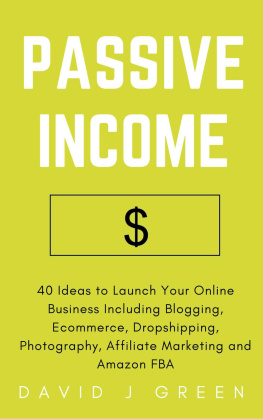The Dollar-a-Minute Locksmith

A Simple Step-by-Step Business Plan for Earning Part-Time or Full-Time Income Re-Keying and Repairing House Locks
David Calvin, A-Best Locksmith
The Dollar-a-Minute Locksmith

A Simple Step-by-Step Business Plan for Earning Part-Time or Full-Time Income Re-Keying and Repairing House Locks
David Calvin, A-Best Locksmith
Copyright 2011
TABLE OF CONTENTS
Introduction
What A-Best Locks mith Looks Like Today
The Purpose of This Book
What You Will Get Out of This Book
Sco pe of the Work to Be Performed
Pricing
Educational Needs
Tools Required
Specific Locksmith Tool List
Lock Distributors
Types, Brands, and Functions of Locks to Be Serviced
Advertising
Business Insurance
Cu stomer Service
Vehicle Ideas
A bout Scam Locksmith Companies
Business Licenses
What Do You Do Now?
Rekeying Locks Cylinders (The Basics of Lock Rekeying Book)
Disassembly of the Kwikset Lockset and Shimming
Introduction
I became a locksmith in 1989 in a small town in Tennessee. After seeing a locksmith charge $85 to extract a broken key from a car ignition and spend only five minutes doing it, I knew that there was easy money to be made in the locksmith industry. Of course, I did not know where or how I could learn the skills necessary to begin the profession; and I guessed correctly that the locksmith I watched making the $85 was not about to tell me!
Like many people, I found a famous locksmith course being advertised in a magazine. I sent off for the brochure and enrolled in the course. Although the course at that time covered some important subjects regarding lock cylinder servicing, I can truly say that most of what I learned was useless. Believe it or not, after I finished the course, I set out in search of clients. That was in 1989.
My first job earned me $35. A friend from church had an old-fashioned mortise lock that needed a key. I removed the lock, took out a skeleton key blank, and filed the key down by hand. I was ecstatic! In one hour I made $35.
It did not take long for other people to find out I was interested in tinkering with locks. Soon, people were calling me for various kinds of lock jobs. To be sure, there were some jobs I did not accept because of my unfamiliarity with a particular lock; but I always showed up, acted confidently, and tried to do the job. Most of the time, I faked it until I made it. That means I approached each lock job carefully knowing that, if a person put a lock together, a person could take it apart and then put it back together!
By 1994, I was doing so much lock work, still part-time, that I decided to quit my full-time job and be a locksmith full-time. The day I made the transition was July 4, 1994. It was Independence Day. By the end of that week, my after parts income was $1800 for one weeks worth of work.
What makes this whole story so fascinating is that today, April 7, 2011, I am grossing $141,000 per year and keeping $80,000. And it gets even better: I am still working less than forty hours per week! In fact, when I estimate actual time spent working on locks, I am working between 20 and 30 hours.
What A-Best Locksmith Looks Like Today
I get up at 7 oclock in the morning and leave the house at 8 oclock. I return at 4 in the afternoon. I serve clients Monday though Friday and do not answer the phone on the weekends. My services are offered to residential and commercial clients and are limited to doors on buildings. I re-key, replace, and repair door locks only. I do not open cars, make ignition keys, drill open safes, install electric locks, install alarms, service soda machines, service safe deposit boxes, or sell and install doors.
Because I choose to live in the country, I drive 80 to 150 miles per day in one of the smallest cars made: A 2008 two-door Ford Focus. At 35 miles per gallon with tools on board, that pretty much takes gas out of the equation. My vehicle is unmarked because clients do not want people knowing that a locksmith is on the premises. It also helps keep your vehicle from being burglarized. I like driving it and parking it. I hate working out of it. However, in todays economy, the money I save in gas is astounding.
The locks I work on include residential locks -- doorknobs or levers and deadbolts. Sometimes customers ask for a peephole. Commercially, I re-key doors, install new locks and panic bars, and repair them. I also replace bad hinges with continuous hinges and install door closers. My high-security key of choice is Mul-T-Lock, and I have them installed from as far south as Winchester, Tennessee, to as far north as Clarksville, Tennessee.
My website is www.a-bestlocksmith.com and includes a do-it-yourself section for residential and commercial clients who wish to repair locks themselves. I also provide information on how to avoid scams, how to select a locksmith, and how to bargain with locksmiths. As you can guess, my competitors hate me.
As time goes on, and as I have chosen to live a simple life, I find I do not need to make as much money as I once did. Eventually, I will whittle my work days down to four, three, and then to two days per week.
My clients include Fluor Daniel, General Mills, Arbys (four states), Pinnacle Bank, Titlemax (Middle Tennessee), Discount Tire (Middle Tennessee), and numerous others.
The Purpose of This Book
This book is designed to give the prospective locksmith a good overview of residential locks work. This book is not a lesson book on how to pick open locks or change locks. There are, however, some descriptions of lock servicing which are included in order to illustrate the simplicity of the services a person will perform as a locksmith. This book has been designed primarily as an information source for people who are doing preliminary research into the residential lock business.
At the end of this book, you will find included my Amazon book The Basics of Lock Cylinder Rekeying. You will also find a complete Kwikset knob breakdown.
What You Will Get Out of This Book
This book is an invaluable source of information for the person considering locksmith work as a source of part-time or full-time income. It can also help you if you are already a locksmith and are looking for suggestions. Specifically, this book will focus on giving interested individuals solid, practical information about residential locksmith work regarding:
1. Scope of work to be performed
2. Pricing
3. Educational needs
4. Tools required and where to buy them
5. Types of locks to be serviced
6. Advertising
7. Insurance
8. Customer service
9. Vehicle Ideas
10. How to take advantage of the locksmith scams that are out there by positioning your company as the honest company
11. Step-by-step rekeying of residential lock cylinders , with illustrations at the end of the book.
Yes, residential lock servicing is a great way to bring in part-time or full-time revenue. It is not hard to learn, and equipment costs are minimal. Can you imagine becoming the residential home lock expert in your area? Can you become the person on whom everybody relies for advice and repair? Of course you can! Also consider that you will be able to serve customers faster and with better customer service than the large locksmith companies in your area. Why? Because you will be the area expert in home lock servicing.
The key to succeeding in this business concept is to stay focused on residential sector service. I cannot stress this enough. If you start out with my business plan and in two weeks start to consider other income streams from other types of lock servicing, you will be overwhelmed. Yes, there may come a time a year or two down the road when you will want to begin serving the commercial sector; but by focusing on residential, your jump to commercial will be much easier and less confusing. Stay focused! Become the best residential guy in your area! When people ask you what you do as a locksmith, you will say, I specialize in residential lock service exclusively.
Next page





